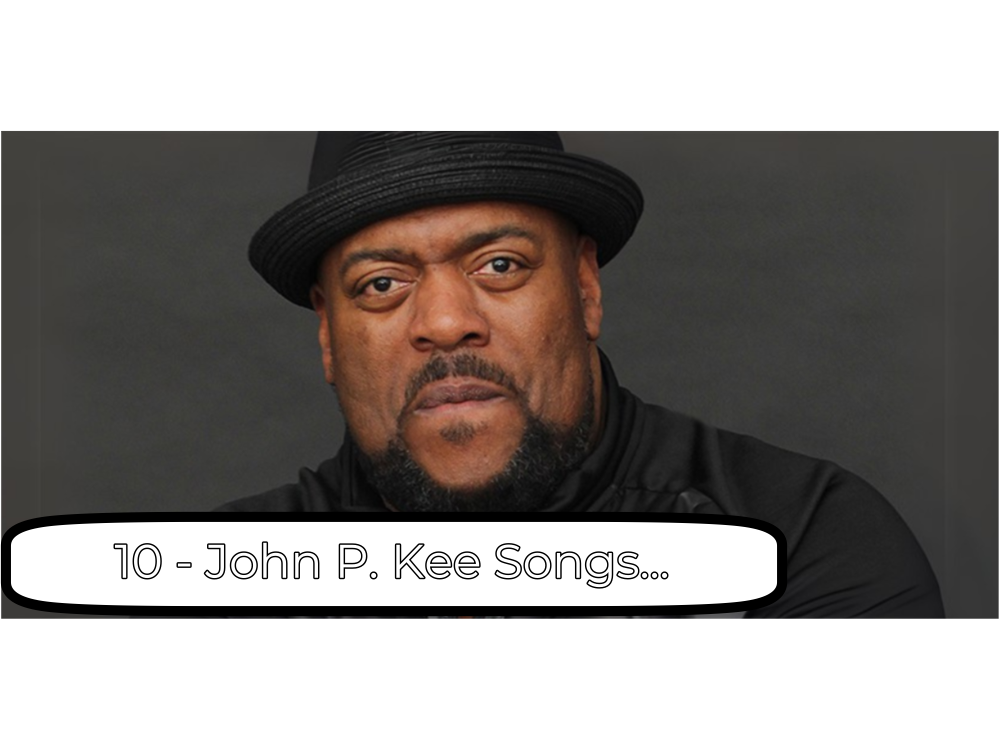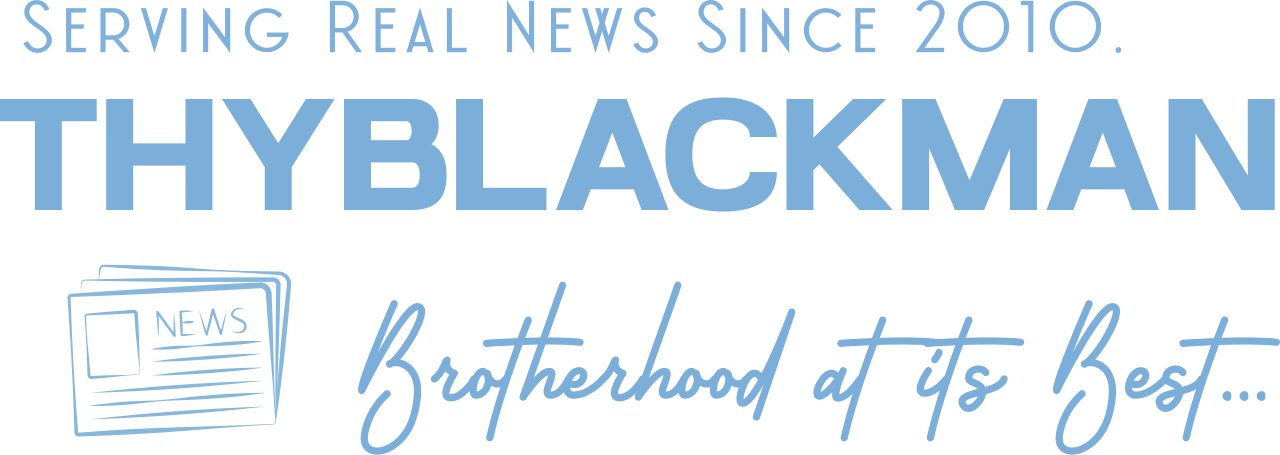(ThyBlackMan.com) If you’ve ever needed a gospel song to carry you through a tough season or lift your spirit when words failed, there’s a good chance John P. Kee has already been that voice for you. For decades, he’s been one of gospel music’s most trusted storytellers—able to reach the brokenhearted and the joyful alike with songs that feel like prayers set to music. Whether you’re new to his music or grew up with his voice filling your church pews, his catalog is rich with songs that still hit home.
I’ve revisited these ten tracks not just for nostalgia but because they still speak truth, still stir the soul, and still meet us where we are. From tender ballads of comfort to high-energy praise anthems, these songs remind us why gospel music remains one of the most powerful forms of spiritual expression—and why John P. Kee’s work continues to resonate in 2025 and beyond.

1. “Jesus Is Real”
“Jesus Is Real” remains one of the most defining songs in John P. Kee’s catalog. Released in the early ‘90s, it showcases the raw, heartfelt conviction that Kee is known for, backed by The New Life Community Choir. What makes this song so enduring is its fusion of traditional gospel structure with the emotional charge of contemporary Black church worship. The repetition of “I know the Lord is real to me” isn’t just a lyric—it’s a declaration.
Musically, the track is layered with rich vocal harmonies, a pulsating bassline, and well-timed cymbal crashes that accentuate the chorus. Kee’s gritty, soulful voice carries the message like a spiritual freight train, never letting up. The instrumentation is classic early-‘90s gospel—thick with organ swells, tambourine punches, and backing vocals that are as much a part of the message as Kee himself. There’s something sacred about the groove; it hits hard enough to stir a crowd, yet sensitive enough to touch a personal place of faith.
One of the most powerful aspects of this track is how it becomes an anthem of assurance for those going through silent battles. Kee isn’t just singing about a theological idea—he’s testifying from a place of experience. The song’s refrain becomes a lifeline for many listeners, especially those questioning their faith or in need of spiritual affirmation. Its live feel only deepens the emotional impact, making it feel like you’re part of something bigger every time you press play.
Even in today’s gospel scene, saturated with digital production and genre-blending, this track remains a staple. Choir directors still use it, praise teams revisit it, and new listeners find comfort in its message. It stands as a timeless testimonial of faith that refuses to age. “Jesus Is Real” isn’t just a gospel song—it’s a spiritual checkpoint, a reminder of the foundational truth that for believers, Jesus isn’t abstract. He’s present, alive, and real.
2. “Lily in the Valley”
With “Lily in the Valley,” John P. Kee ventured into a more contemporary sound without compromising his gospel roots. The song opens with a subdued yet powerful piano introduction, soon followed by lush harmonies that set a reflective mood. The title metaphor is biblically rich—Jesus as the lily in the valley—and Kee’s delivery brings that imagery to life. It’s a gentle invitation to meet Christ in the low places, a message that resonates with anyone who has walked through seasons of hardship.
His vocal performance here is slightly more restrained than on some of his more declarative tracks, and that subtlety pays off. There’s a tenderness in his tone, especially during the verses, that draws the listener into a space of meditation. It feels like Kee is walking with you through the valley, not shouting from a mountaintop. This intimacy is one of the track’s strongest qualities—it’s pastoral in tone, yet musically captivating.
The arrangement cleverly balances gospel tradition with smooth R&B textures, allowing for broader audience reach. Synth pads and soft percussion are used sparingly but effectively, while the layered background vocals glide in and out like a warm breeze. This crossover appeal makes “Lily in the Valley” a unique offering—one that doesn’t alienate older gospel fans while simultaneously speaking to younger listeners raised on urban contemporary soul.
It’s a track you return to when you need calm assurance. In a world of noise and chaos, this song is a sanctuary. Kee isn’t just singing about Jesus being in the valley—he’s inviting you to find Him there with him. For today’s listener, this song is a balm during personal trials, and its peaceful tone continues to make it a standout in gospel playlists and reflective worship sets alike.
3. “Standing in the Need”
“Standing in the Need” is gospel urgency incarnate. From the first note, John P. Kee commands your attention with a rousing introduction that segues into a pulsating choir entrance. There’s an almost theatrical sense of tension and release, driven by syncopated drums, swelling keys, and a call-and-response that feels as ancient as it is immediate. It’s a masterclass in how to turn vulnerability into power through music.
Lyrically, the song captures a universal cry for help—“Not my brother, not my sister, but it’s me, O Lord.” The language is old-school gospel, but Kee infuses it with fresh vitality. He doesn’t just perform the song; he inhabits it. You can hear desperation and hope colliding in every note. Kee’s voice cracks in the right places, emphasizing the plea, not polishing it. It’s raw gospel emotion done right.
One of the highlights is the dynamic choral backing, which acts like a congregation testifying right along with Kee. This communal atmosphere transforms the song into more than just a solo moment—it becomes a shared worship experience. The crescendo builds and crashes like waves—lifting the listener higher with every chorus until the final plea feels like a collective prayer from everyone in the room.
In 2025, “Standing in the Need” still resonates because spiritual vulnerability never goes out of style. Whether you’re at home, in your car, or in a packed church, this track serves as a soul-level reminder that it’s okay to cry out for help. It’s one of those songs you can loop during a tough night and let it say everything you don’t have the strength to say. Kee gives permission to be needy before God—and in doing so, he gives strength to others.
4. “I Do Worship”
Few gospel ballads reach the intimacy of “I Do Worship.” Recorded live, this song captures not just Kee’s voice, but his spirit. The gentle introduction leads with a calming keyboard melody and an atmosphere of deep reverence, allowing the listener to exhale. You can almost hear the audience breathing along with him, caught in the quiet sanctity of the moment.
Vocally, Kee is in top form—subdued, but deeply emotive. He allows the lyrics to breathe, never rushing a phrase. “I do worship You” is repeated as a gentle affirmation, growing in intensity as the song progresses. It’s as much a prayer as it is a performance. Each line feels soaked in personal experience. It doesn’t come off as scripted or rehearsed—it sounds lived-in, like a worship that had been marinating in silence for years.
What sets this song apart is its build-up. It begins with solo vulnerability and gradually incorporates the voices of the choir, symbolizing how personal devotion transforms into corporate worship. The background vocals are smooth, tight, and perfectly complementary—never overshadowing Kee, but never fading either. The transitions are fluid and moving, like spiritual waves washing over the listener.
This song remains relevant because worship doesn’t age. In a fast-paced culture, “I Do Worship” slows us down and redirects focus to the divine. It’s a favorite in prayer services, devotionals, and even small group worship settings. What’s more impressive is how it manages to feel both massive and intimate—grand in purpose, yet personal in tone. In that sacred balance, John P. Kee delivers one of gospel music’s purest moments of adoration.
5. “He’s Able”
“He’s Able” is one of John P. Kee’s most uplifting and declarative songs—a bold proclamation of God’s power and faithfulness. From the opening chords, there’s a sense of forward momentum, as if the song itself is reaching toward heaven. Kee wastes no time getting to the heart of the message: “Don’t give up on God, ‘cause He won’t give up on you.” It’s more than a lyric—it’s a lifeline, especially for those feeling weary in their faith walk or isolated by hardship.
Musically, “He’s Able” builds on Kee’s signature fusion of traditional gospel with a contemporary gospel choir flair. The rhythm section lays down a steady groove that feels both worshipful and empowering, while the choir acts as a spiritual anchor—responding to Kee’s call with explosive affirmations of faith. Horn stabs and rhythm guitar provide a subtle funk undertone, giving the track a vibrant feel without distracting from the message. The arrangement is structured like a steady climb, leading the listener upward toward a climactic moment of unshakable belief.
Kee’s voice is rich and assertive, filled with the kind of conviction that comes from lived experience. There’s no hesitation or doubt in his delivery—only the unwavering tone of someone who has both seen and survived. He sings like a man who knows what it means to wait on God, to hold on through uncertainty, and to come out stronger on the other side. His ad-libs near the end of the song are particularly powerful, as they sound like spontaneous praise—natural, unrehearsed, and completely heartfelt.
The strength of “He’s Able” lies not just in its theological message, but in its emotional accessibility. Whether you’re sitting in the pews or riding in your car with your head full of worry, this song feels like it reaches across time and space to grab your hand. The repetition of “He’s able” functions like an incantation—each repetition solidifies the truth a little deeper, chiseling away at fear and doubt.
Even decades after its release, “He’s Able” continues to encourage listeners facing personal storms, professional setbacks, or spiritual fatigue. It’s more than just a praise song—it’s a prophetic reminder of divine ability. Kee reminds us that God isn’t just a concept, but an active force working for us, through us, and around us. In a world full of instability, this track remains a solid rock of hope and empowerment. It’s no surprise that churches still sing it today. It’s timeless, powerful, and unmistakably Kee.
6. “He’ll Welcome Me”
“He’ll Welcome Me” walks the fine line between lament and triumph—and does it masterfully. This is the kind of song that speaks directly to the weary soul, the tired believer, the person who’s been running this race called life and wonders how it all ends. It answers that question with a vision of heavenly reception: not judgment, not rejection, but a divine embrace.
John P. Kee’s voice is a vessel here. He doesn’t belt for effect; he sings with reverence. The emotional restraint in his voice adds more weight than if he shouted from the mountaintop. He understands that some truths are whispered—not screamed. The repeated plea, “He’ll welcome me,” becomes a mantra of hope, echoing long after the music fades.
The instrumentation is delicate and almost cinematic. Lush strings swell under Kee’s voice, and subtle piano chords punctuate moments of reflection. It feels intimate, like you’re sitting in the back pew of a small church listening to someone pour their soul out in song. The background vocals are angelic—soft and reverent, yet full of presence.
“He’ll Welcome Me” has become a staple at funerals and homegoing celebrations, but it’s more than a song of parting—it’s a song of preparation. It challenges listeners to live right, love deep, and leave nothing unsaid. And for those still in the trenches of life, it offers reassurance: that when the last note is sung, you will be received with open arms.
7. “I Shall Do”
“I Shall Do” is a song of commitment—a spiritual pledge wrapped in music. Unlike the more explosive praise tracks in Kee’s catalog, this one carries a quiet strength. It’s contemplative but firm, meditative but decisive. Kee uses it to explore the weight of saying “yes” to God’s will, and in doing so, offers listeners a template for surrender and obedience. In many ways, it’s the kind of gospel song that meets the believer at the crossroads—the moment when talk has to turn into action.
The melody is rich with emotion, driven by smooth keys, subtle bass, and Kee’s signature layered choir harmonies. It opens gently, as if knocking on the heart, inviting listeners into stillness. The instrumentation doesn’t overreach—it supports the message without trying to overpower it. That space is crucial because every line in this song feels like a prayer, a moment of personal reckoning between the singer and the Savior. The piano lines, though simple, ripple with reverence, giving the song a confessional feel that lingers well beyond the final note.
Vocally, Kee doesn’t over-embellish. He leans into the words rather than around them, letting his phrasing carry the weight of conviction. There’s something profoundly moving about the simplicity in how he declares, “I shall do what He says.” It’s an ordinary sentence transformed into a sacred vow. Kee’s voice doesn’t shout this promise—it submits to it. You can hear the humility in every word, as though he’s not just performing the song—he’s living it. Meanwhile, the background vocals respond gently, like a congregation affirming their own readiness to follow God’s will.
What makes “I Shall Do” stand out is its honesty. It doesn’t pretend that obedience is always easy. Instead, it reverently explores the internal process of yielding to God’s plan even when it’s uncertain or uncomfortable. That’s why this song often finds its way into altar calls, prayer nights, and quiet moments of surrender. It doesn’t just ask the listener to lift their hands—it challenges them to lift their will.
“I Shall Do” remains a favorite for personal reflection because it resonates with anyone who has ever felt the tension between calling and comfort. It’s a song for when you’re ready to commit, when you’re done running, and when you realize that obedience is not just an obligation—it’s an act of worship. Kee doesn’t just sing it; he means it. And when you hear it, especially in the stillness of a late-night replay or the intimacy of a morning prayer, you just might find yourself meaning it too.
8. “Show Up!”
“Show Up!” is the sonic equivalent of a spiritual alarm clock. From the very first note, it grabs you by the collar and says, “God is real—and He moves.” This isn’t a song for passive worship; it’s a call to expect the miraculous. Kee taps into a long tradition of Black church praise music, where desperation and celebration dance hand-in-hand.
The structure is explosive: it builds, breaks, and rebuilds again. There are moments where the choir sounds like it might blow the roof off—and that’s by design. The energy is electric, like the final crescendo of a revival service. Kee’s voice punches through the mix with intensity and clarity. He doesn’t ask God to show up—he demands it, knowing that God will.
What makes this song stand out is its ability to straddle multiple gospel styles. There are hints of traditional church stomp, 90s gospel groove, and even Pentecostal flair. The drums hit hard, the keys shimmer, and the choir attacks every phrase like they mean it. The live version is even more potent, often stretching out with ad-libs and crowd participation that turn it into a full-blown worship event.
“Show Up!” is timeless because it speaks to a universal need: divine intervention. Whether you’re facing a crisis, seeking a breakthrough, or just trying to make it through Monday, this song reminds you that God doesn’t clock out. He shows up—every time.
9. “Praying for You”
This song stands apart in John P. Kee’s repertoire for its pastoral tenderness. “Praying for You” isn’t a performance—it’s a letter of love and concern to those in spiritual or emotional need. Kee’s voice is both soothing and direct, offering comfort like a seasoned shepherd to his flock. His tone carries the weight of compassion, almost as if each word is meant to individually wrap around the listener’s heart.
The instrumentation is soft and slow, with a piano line that mimics the feel of a lullaby. Background harmonies are present but used sparingly, allowing Kee’s voice to take center stage. This minimalism heightens the emotional gravity of the lyrics. There are no flashy vocal runs or dramatic crescendos—just earnest words, a calm tempo, and a warm sincerity that speaks volumes in its simplicity. The musical structure allows each listener to place themselves in the seat of the one being prayed for.
What truly elevates this song is its understanding of timing and restraint. Unlike some gospel tracks that encourage shouting or clapping, “Praying for You” encourages stillness and reflection. It’s the kind of song you send to someone going through a storm—a musical hug, if you will. In an era where so much gospel music leans into celebratory tones, this song instead offers sanctuary. It says, “You don’t have to pretend to be strong right now—I’m interceding for you.”
Years later, the message is still essential. The song reminds us that spiritual support doesn’t always have to be loud—it can be gentle, sincere, and deeply moving. It’s also a call for believers to remain connected, not just through words but through action and prayer. In a world where encouragement is often fleeting or conditional, “Praying for You” stands as a gospel reminder that compassion is still one of the most powerful forms of ministry.
10. “Clap Your Hands”
Closing out this list is the infectious “Clap Your Hands,” which leans heavily into the upbeat, foot-stomping tradition of celebratory gospel. This is John P. Kee at his most energetic—commanding, jubilant, and undeniably fun. The energy is high from the very first beat, and the track carries that momentum all the way through like a runaway praise train.
The track kicks off with driving percussion and immediately invites the listener into movement. It’s impossible to sit still during this one. Kee’s call-and-response with the choir pushes the energy to a near-praise break level. The drums hit hard, the horns punch through the mix, and the claps become part of the rhythm section themselves. It’s organized chaos—the beautiful kind you find in churches where joy can’t be contained.
Lyrically, the song doesn’t overcomplicate things. It’s a reminder to praise God in all things and at all times. That simplicity is what makes it so universally accessible—whether you’re five or ninety-five, the command is the same: clap your hands and give Him praise. It taps into a primal kind of praise, where the body becomes an instrument, and joy takes over without needing an elaborate setup.
Even today, this track remains a favorite for congregational worship and gospel concerts. It’s not just music—it’s movement, it’s energy, it’s joy. It proves that praise can be as physical as it is spiritual. “Clap Your Hands” reminds us that worship doesn’t always have to be solemn—it can be full of celebration, laughter, and movement. It’s the kind of track that lifts a room, turns burdens into dance, and brings communities together around one simple act of praise.
These ten songs are more than just highlights from a legendary gospel career—they’re moments. Moments where healing begins, praise breaks out, and the presence of God feels just a little bit closer. John P. Kee has a rare gift for turning scripture into sound and struggle into song. His music isn’t just about faith; it’s a reflection of the walk, the wrestle, and the worship we all live through.
Whether you’ve been with him since “Jesus Is Real” or are discovering his work for the first time, these tracks are a powerful place to start—or return to. They still speak, still move, and still minister. So turn them up, let them play, and let them remind you that gospel music—real gospel music—isn’t going anywhere.
Staff Writer; Jamar Jackson

















Leave a Reply